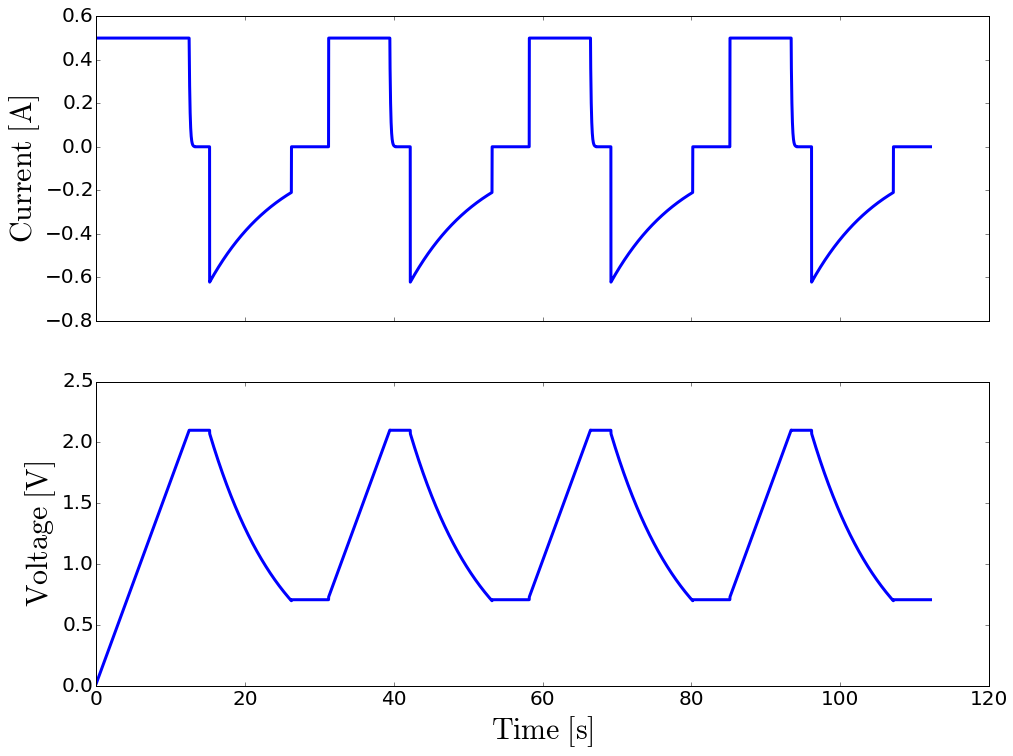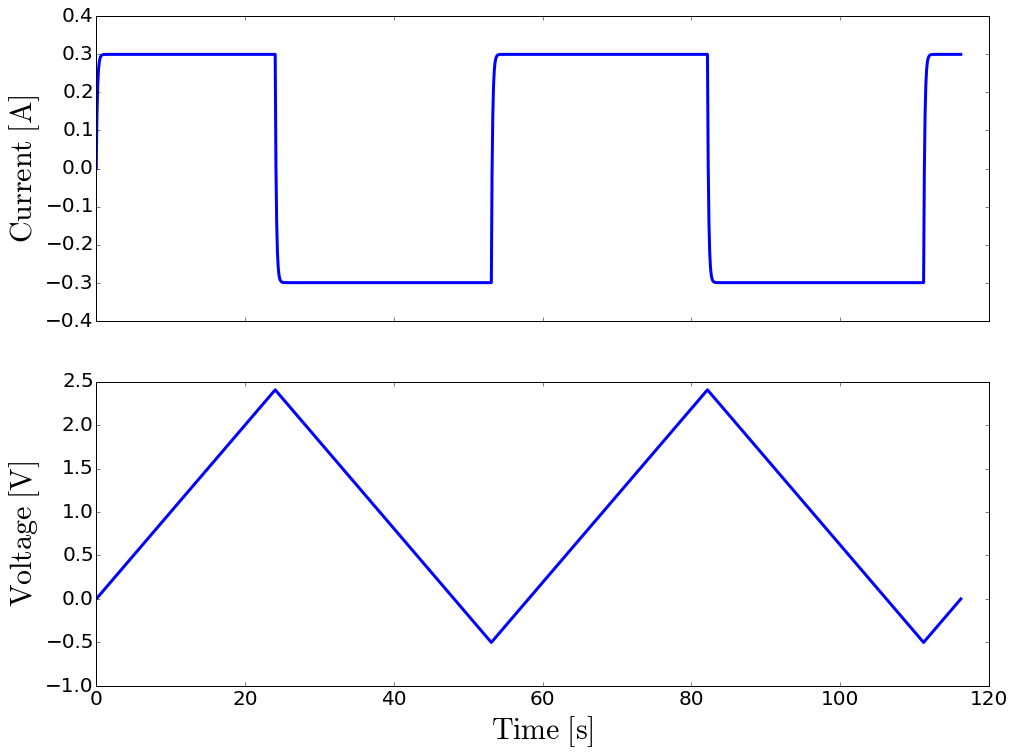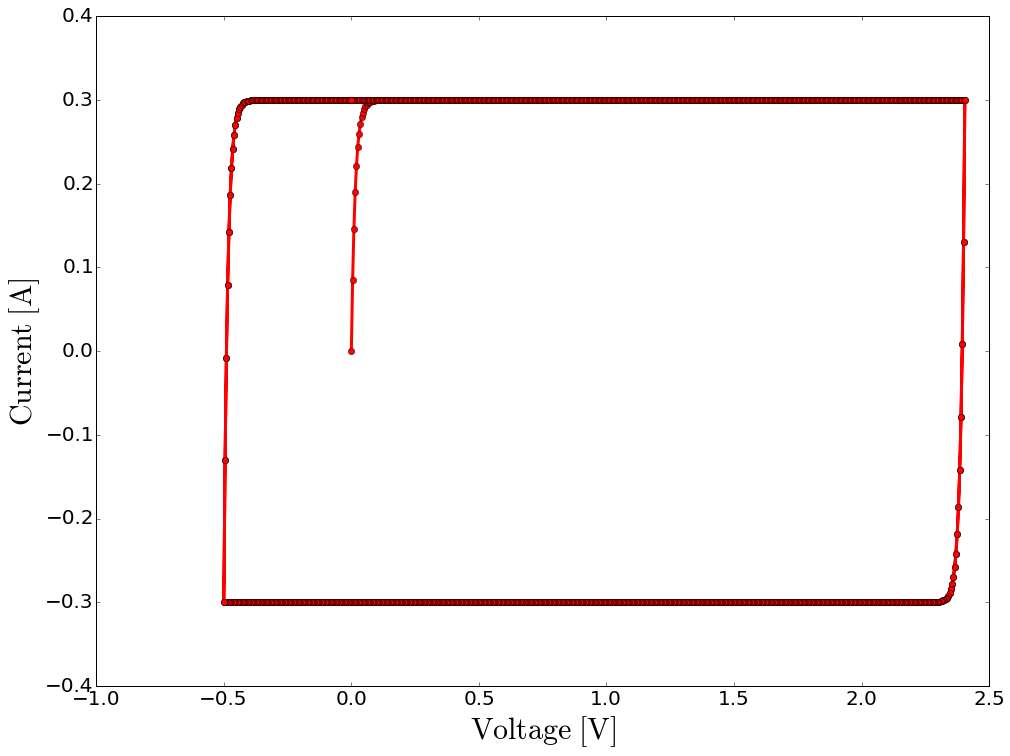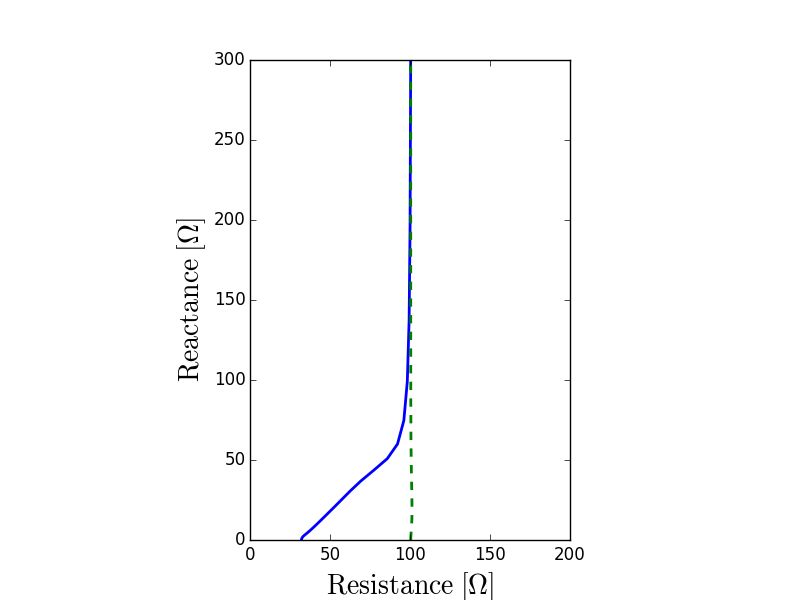Electrochemical techniques¶
Cyclic charge discharge¶
Cyclic Charge-Discharge is a common technique used to test the performance and cycle-life of energy storage devices. Most often, the charge and discharge are conducted at constant current until a set voltage is reached.
The following implements 4 cycles of a repetitive loop through several steps:
- constant current charge at
 until voltage
reaches a
until voltage
reaches a  limit
limit - potentiostatic hold until the current falls below
 for a maximum duration time of
for a maximum duration time of

- rest at open circuit potential for

- constant load discharge at
 to
to

- rest at open circuit potential for

from pycap import PropertyTree,CyclicChargeDischarge,EnergyStorageDevice
# setup the experiment
ptree=PropertyTree()
ptree.put_string('start_with','charge')
ptree.put_int ('cycles',4)
ptree.put_double('time_step',0.01)
ptree.put_string('charge_mode','constant_current')
ptree.put_double('charge_current',0.5)
ptree.put_string('charge_stop_at_1','voltage_greater_than')
ptree.put_double('charge_voltage_limit',2.1)
ptree.put_bool ('charge_voltage_finish',True)
ptree.put_double('charge_voltage_finish_max_time',180)
ptree.put_double('charge_voltage_finish_current_limit',1e-3)
ptree.put_double('charge_rest_time',2)
ptree.put_string('discharge_mode','constant_load')
ptree.put_double('discharge_load',3.33)
ptree.put_string('discharge_stop_at_1','voltage_less_than')
ptree.put_double('discharge_voltage_limit',0.7)
ptree.put_double('discharge_rest_time',5)
ccd=CyclicChargeDischarge(ptree)
The property tree is populated interactively here but it can parse directly an input file. Please refer to other examples.
The CCD experiment can be started with a charge or a discharge
step. The length of the test is defined by the cycle number and the loop
end criteria.
The charge mode can be constant_current, constant_voltage, or
constant_power. Two end criteria can be selected although only one
is required. Note that they are no safeguards and poor end criteria
will produce infinite loops!
If voltage_finish is enabled (default value is False), the charge step
proceeds to a potentiostatic step that ends after reaching the specified time
voltage_finish_max_time or when the current falls between the limiting value
voltage_finish_current_limit (absolute value).
The voltage finish step makes little sense in case of a constant voltage charge
and therefore is not allowed.
The charge ends with an optional rest time period before proceeding with the
next step.
The discharge process can be perfomed in four different modes:
contant_current, contant_voltage, constant_power, or
constant_load. End criteria must be chosen carfully here as well.
Let’s build an energy storage device, here a simple series RC circuit,
with a  resistor and a
resistor and a  capacitor, and run the experiment.
capacitor, and run the experiment.
# build an energy storage device
ptree=PropertyTree()
ptree.put_string('type','SeriesRC')
ptree.put_double('series_resistance',40e-3)
ptree.put_double('capacitance',3)
device=EnergyStorageDevice(ptree)
from pycap import initialize_data,plot_data
# run the experiment and visualize the measured data
data=initialize_data()
steps=ccd.run(device,data)
print "%d steps"%steps
%matplotlib inline
plot_data(data)
11213 time steps ( ) are required to complete
the CCD experiment. Below are plotted the measured current and voltage data
versus time.
) are required to complete
the CCD experiment. Below are plotted the measured current and voltage data
versus time.

Cyclic voltammetry¶
Cyclic Voltammetry (CV) is a widely-used electrochemical technique to investigate energy storage devices. It consists in measuring the current while varying linearly the voltage back and forth over a given range.
The voltage sweep applied to the device creates a current given by

where  is the current in ampere and
is the current in ampere and  is
the scan rate of the voltage ramp.
is
the scan rate of the voltage ramp.
The voltage scan rates for testing energy storage devices are usually
between  and
and  . Scan
rates at the lower end of this range allow slow processes to occur; fast
scans often show lower capacitance than slower scans and may produce
large currents on high-value capacitors.
. Scan
rates at the lower end of this range allow slow processes to occur; fast
scans often show lower capacitance than slower scans and may produce
large currents on high-value capacitors.
from pycap import PropertyTree, CyclicVoltammetry
# setup the experiment
ptree = PropertyTree()
ptree.put_double('initial_voltage', 0) # volt
ptree.put_double('final_voltage', 0) # volt
ptree.put_double('scan_limit_1', 2.4) # volt
ptree.put_double('scan_limit_2', -0.5) # volt
ptree.put_double('scan_rate', 100e-3) # volt per second
ptree.put_double('step_size', 5e-3) # volt
ptree.put_int('cycles', 2)
cv = CyclicVoltammetry(ptree)
Four parameters define the CV sweep range: The scan starts at
initial_voltage, ramps to scan_limit_1, reverses and goes to
scan_limit_2. Additional cycles start and end at scan_limit_2.
The scan ends at final_voltage. Here, the sweep range is
[ ,
,  ]. It both starts and
finishes at
]. It both starts and
finishes at  .
.
The rate of voltage change over time  is specified
using
is specified
using scan_rate which is here set to  . The
linear ramp is imposed in increments of
. The
linear ramp is imposed in increments of  . The
number of sweep is controlled by
. The
number of sweep is controlled by cycles.
Here we run the experiment with a  capacitor in
series with a
capacitor in
series with a  resistor.
resistor.
# build an energy storage device
ptree=PropertyTree()
ptree.put_string('type','SeriesRC')
ptree.put_double('capacitance',3)
ptree.put_double('series_resistance',50e-3)
device=EnergyStorageDevice(ptree)
from pycap import initialize_data,report_data,plot_data
from pycap import plot_cyclic_voltammogram
# run the experiment and visualize the measured data
data=initialize_data()
steps=cv.run(device,data)
print "%d steps"%steps
%matplotlib inline
plot_data(data)
plot_cyclic_voltammogram(data)
2320 steps


On the CV plot (current on the y-axis and voltage on the x-axis), we read

as expected for a  capacitor. For an ideal
capacitor (i.e. no equivalent series resistance), the plot would be a
perfect rectangle. The resistor causes the slow rise in the current at
the scan’s start and rounds two corners of the rectangle. The time
constant
capacitor. For an ideal
capacitor (i.e. no equivalent series resistance), the plot would be a
perfect rectangle. The resistor causes the slow rise in the current at
the scan’s start and rounds two corners of the rectangle. The time
constant  controls rounding of corners.
controls rounding of corners.
Electrochemical impedance spectroscopy¶
Electrochemical Impedance Spectroscopy (EIS) is a powerful experimental method for characterizing electrochemical systems. This technique measures the complex impedance of the device over a range of frequencies.
A sinusoidal excitation signal (potential or current) is applied:

That signal consists in the superposition of AC sine waves with amplitude
 , angular frequency
, angular frequency  , and phase shift
, and phase shift
 .
.  is the DC component.
is the DC component.
; `eis.info` file
frequency_upper_limit 1e+3 ; hertz
frequency_lower_limit 1e-2 ; hertz
steps_per_decade 6
cycles 2
ignore_cycles 1
steps_per_cycle 128
harmonics 1
dc_voltage 0 ; volt
amplitudes 5e-3 ; volt
phases 0 ; degree
In the input data above:
frequency_upper_limit,frequency_lower_limit, andsteps_per_decadedefine the frequency range and the resolution on a log scale (for the fundamental frequency). Frequencies are scanned from the upper limit to the lower one.- Electric current and potential signals are sampled at regular time interval
and
steps_per_cyclecontrols the size of that interval.ignore_cyclesallows to truncate the data in the Fourier analysis. It is best when(cycles - ignore_cycles) * steps_per_cycleis a power of two (most efficient in the discrete Fourier transform) but this does not have to be so. harmonicsallows to select what harmonics of the fundamental
frequency
of the fundamental
frequency  to excite.
to excite. amplitudesandphasesare used to specify and
and  , respectively. They may be given
as arrays and must have the same size. This multi-sine feature is
experimental though. In principle, exciting simultaneously multiple
frequencies reduces the computational cost associated with a full spectrum
acquisition, but in practice, it is hard to maintain the quality of the data
measurement without increasing the number of steps.
, respectively. They may be given
as arrays and must have the same size. This multi-sine feature is
experimental though. In principle, exciting simultaneously multiple
frequencies reduces the computational cost associated with a full spectrum
acquisition, but in practice, it is hard to maintain the quality of the data
measurement without increasing the number of steps.
Below is an example of EIS measurement using Cap:
from pycap import PropertyTree, ElectrochemicalImpedanceSpectroscopy,\
NyquistPlot
# setup the experiment
ptree = PropertyTree()
ptree.parse.info('eis.info')
eis = ElectrochemicalImpedanceSpectroscopy(ptree)
# build an energy storage device and run the EIS measurement
eis.run(device)
# visualize the impedance spectrum
nyquist = NyquistPlot(filename='nyquist.png')
nyquist.update(eis)

On the Nyquist plot above, the solid blue line shows the impedance of a supercapacitor on the complex plane with the typical 45 degrees slope for the higher frequencies. The vertical dashed green line corresponds to an equivalent RC circuit.
Ragone plot¶
Conceptually, the y-axis describes how much energy is available and the the x-axis shows how quickly that energy can be delivered.